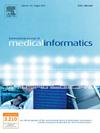Enhancing readmission prediction model in older stroke patients by integrating insight from readiness for hospital discharge: Prospective cohort study
IF 3.7
2区 医学
Q2 COMPUTER SCIENCE, INFORMATION SYSTEMS
International Journal of Medical Informatics
Pub Date : 2025-02-22
DOI:10.1016/j.ijmedinf.2025.105845
引用次数: 0
Abstract
Background
The 30-day hospital readmission rate is a key indicator of healthcare quality and system efficiency. This study aimed to develop machine-learning (ML) models to predict unplanned 30-day readmissions in older patients with ischemic stroke (IS) using a prospective cohort design.
Methods
Patients were divided into two datasets: dataset I (January 2020–December 2021) for model development and dataset II (January 2022–December 2023) for validation. A diffusion model was applied to address data imbalance. Eleven machine-learning methods, including Random Forest (RF), Logistic Regression, CatBoost, eXtreme Gradient Boosting Light Gradient Boosting Machine, K-Nearest Neighbors Support Vector Machine, Multi-Layer Perceptron, and Gaussian Naive Bayes, and 2 ensemble learning models, were constructed to predict readmissions. Bayesian optimization was used to fine-tune the hyperparameters of these models. Model performance was primarily evaluated using the area under the receiver operating characteristic curve (AUC). Shapley Additive Explanations (SHAP) were utilized to identify and interpret the significance of predictive variables.
Results
Dataset I included 489 patients, while dataset II comprised 418 patients, with readmission rates of 15.3 % and 16.0 %, respectively. The RF model achieved the highest predictive performance (AUC = 0.9116, sensitivity = 0.8806, specificity = 0.7806). SHAP analysis identified readiness for hospital discharge as the most significant predictor of readmission.
Conclusion
The RF model shows promise for predicting unplanned 30-day readmissions in older patients with IS. Multi-center studies with larger sample sizes are needed to validate these findings.
通过整合出院准备度来增强老年脑卒中患者再入院预测模型:前瞻性队列研究
30天住院再入院率是衡量医疗质量和系统效率的重要指标。本研究旨在开发机器学习(ML)模型,利用前瞻性队列设计预测老年缺血性卒中(IS)患者30天内的意外再入院情况。方法将患者分为两个数据集:数据集I(2020年1月- 2021年12月)用于模型开发,数据集II(2022年1月- 2023年12月)用于验证。采用扩散模型解决数据不平衡问题。构建了11种机器学习方法,包括随机森林(RF)、逻辑回归、CatBoost、极端梯度增强光梯度增强机、k近邻支持向量机、多层感知机和高斯朴素贝叶斯,以及2个集成学习模型来预测再住院。采用贝叶斯优化对这些模型的超参数进行微调。模型的性能主要是用接受者工作特征曲线下的面积(AUC)来评估的。Shapley加性解释(SHAP)用于识别和解释预测变量的显著性。结果数据集I纳入489例患者,数据集II纳入418例患者,再入院率分别为15.3%和16.0%。RF模型预测效果最佳(AUC = 0.9116,灵敏度= 0.8806,特异性= 0.7806)。SHAP分析确定出院准备是再入院最重要的预测因素。结论射频模型在预测老年IS患者30天内的非计划再入院方面表现出良好的前景。需要更大样本量的多中心研究来验证这些发现。
本文章由计算机程序翻译,如有差异,请以英文原文为准。
求助全文
约1分钟内获得全文
求助全文
来源期刊

International Journal of Medical Informatics
医学-计算机:信息系统
CiteScore
8.90
自引率
4.10%
发文量
217
审稿时长
42 days
期刊介绍:
International Journal of Medical Informatics provides an international medium for dissemination of original results and interpretative reviews concerning the field of medical informatics. The Journal emphasizes the evaluation of systems in healthcare settings.
The scope of journal covers:
Information systems, including national or international registration systems, hospital information systems, departmental and/or physician''s office systems, document handling systems, electronic medical record systems, standardization, systems integration etc.;
Computer-aided medical decision support systems using heuristic, algorithmic and/or statistical methods as exemplified in decision theory, protocol development, artificial intelligence, etc.
Educational computer based programs pertaining to medical informatics or medicine in general;
Organizational, economic, social, clinical impact, ethical and cost-benefit aspects of IT applications in health care.
 求助内容:
求助内容: 应助结果提醒方式:
应助结果提醒方式:


